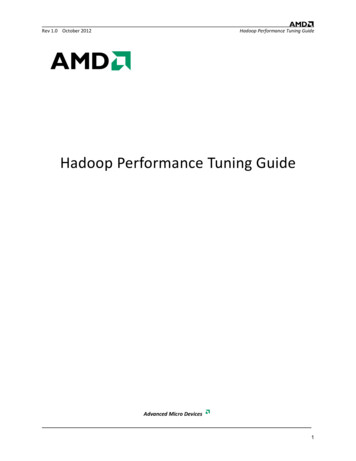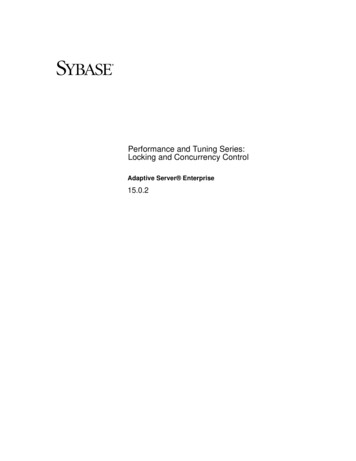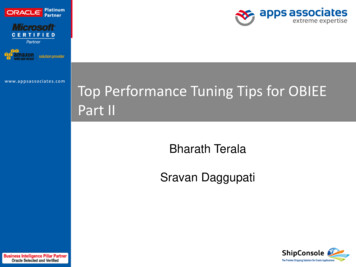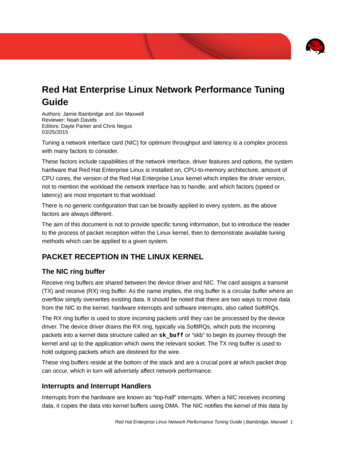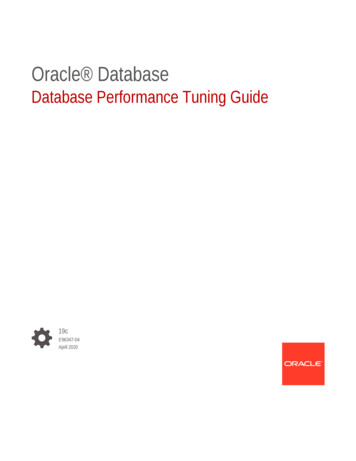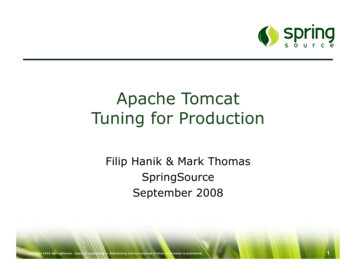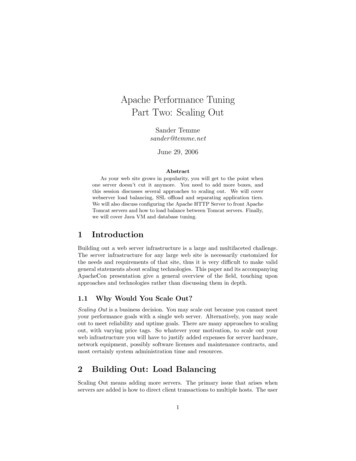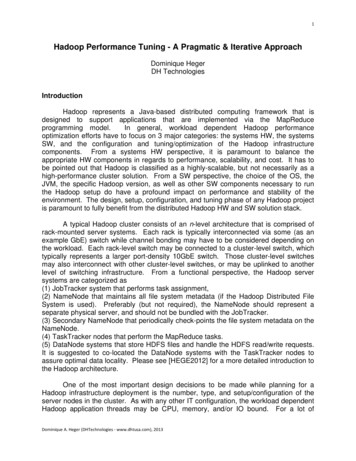
Transcription
1Hadoop Performance Tuning - A Pragmatic & Iterative ApproachDominique HegerDH TechnologiesIntroductionHadoop represents a Java-based distributed computing framework that isdesigned to support applications that are implemented via the MapReduceprogramming model.In general, workload dependent Hadoop performanceoptimization efforts have to focus on 3 major categories: the systems HW, the systemsSW, and the configuration and tuning/optimization of the Hadoop infrastructurecomponents. From a systems HW perspective, it is paramount to balance theappropriate HW components in regards to performance, scalability, and cost. It has tobe pointed out that Hadoop is classified as a highly-scalable, but not necessarily as ahigh-performance cluster solution. From a SW perspective, the choice of the OS, theJVM, the specific Hadoop version, as well as other SW components necessary to runthe Hadoop setup do have a profound impact on performance and stability of theenvironment. The design, setup, configuration, and tuning phase of any Hadoop projectis paramount to fully benefit from the distributed Hadoop HW and SW solution stack.A typical Hadoop cluster consists of an n-level architecture that is comprised ofrack-mounted server systems. Each rack is typically interconnected via some (as anexample GbE) switch while channel bonding may have to be considered depending onthe workload. Each rack-level switch may be connected to a cluster-level switch, whichtypically represents a larger port-density 10GbE switch. Those cluster-level switchesmay also interconnect with other cluster-level switches, or may be uplinked to anotherlevel of switching infrastructure. From a functional perspective, the Hadoop serversystems are categorized as(1) JobTracker system that performs task assignment,(2) NameNode that maintains all file system metadata (if the Hadoop Distributed FileSystem is used). Preferably (but not required), the NameNode should represent aseparate physical server, and should not be bundled with the JobTracker.(3) Secondary NameNode that periodically check-points the file system metadata on theNameNode.(4) TaskTracker nodes that perform the MapReduce tasks.(5) DataNode systems that store HDFS files and handle the HDFS read/write requests.It is suggested to co-located the DataNode systems with the TaskTracker nodes toassure optimal data locality. Please see [HEGE2012] for a more detailed introduction tothe Hadoop architecture.One of the most important design decisions to be made while planning for aHadoop infrastructure deployment is the number, type, and setup/configuration of theserver nodes in the cluster. As with any other IT configuration, the workload dependentHadoop application threads may be CPU, memory, and/or IO bound. For a lot ofDominique A. Heger (DHTechnologies ‐ www.dhtusa.com), 2013
2Hadoop installations, contemporary dual-socket server systems are used. These serversystems are normally preferred to larger SMP nodes from a cost-benefit perspective,and do provide good load-balancing and thread concurrency perspectives. For mostHadoop installations (workload dependent), configuring a few hard drives per servernode is sufficient. For Hadoop workloads that are highly IO intensive, it may benecessary to configure higher ratios of disks to available cores. Most Hadoopinstallation use 1TB drives. While it would be feasible to use RAID solutions, theusage of RAID systems with Hadoop servers is generally not recommended, asredundancy is build into the HDFS framework (via replicating blocks across multiplenodes). Sufficient memory capacity per server node is paramount, as executingconcurrent MapReduce tasks at high throughput rates is required to achieve goodaggregate cluster performance behavior. From an OS perspective, it is suggested torun Hadoop on a contemporary Linux kernel. Newer Linux kernels provide a muchimproved threading behavior and are more energy efficient. With large Hadoop clusters,any power inefficiency amounts to significant (unnecessary) energy costs.Opportunities and ChallengesHadoop is considered a large and complex SW framework that incorporates anumber of components that interact among each other across multiple HW systems.Bottlenecks in a subset of the HW can cause overall performance issues for anyHadoop workload. Hadoop performance is sensitive to every component of the stack,including Hadoop/HDFS, JVM, OS, NW, the underlying HW, as well as possibly theBIOS settings. Every Hadoop version is distributed with a VERY large set ofconfiguration parameters, and a rather large subset of these parameters can potentiallyimpact performance. It has to be pointed out though that one cannot optimize aHW/SW infrastructure if one does not understand the internals and interrelationships ofthe HW/SW components. Or in other words, one cannot tune what one does notunderstand, and one cannot improve what one cannot measure. Hence, adjustingthese configuration parameters to optimize performance requires the knowledge of theinternal working of the Hadoop framework. As with any other SW system, someparameters impact other parameter values. Hence, it is paramount to use apragmatic/iterative process, as well as several measurement tools, to tune a Hadoopenvironment. The approach outlined in this paper is based on an actual tuning cyclewhere Hadoop and Linux workload generators are used, data is collected and analyzed,and potential bottlenecks are identified and addressed until the Hadoop clustermeets/exceeds expectations. It is paramount to not only address the HW or the OS, butalso to scrutinize the actual MapReduce code and potentially re-write some of theprocedures to improve the aggregate performance behavior.Monitoring and Profiling ToolsSome of the tools used to monitor Hadoop jobs include: Ganglia and Nagios represent distributed monitoring systems that capture/reportvarious system performance statistics such as CPU utilization, NW utilization,Dominique A. Heger (DHTechnologies ‐ www.dhtusa.com), 2013
3memory usage, or load on the cluster. These tools are effective in monitoring theoverall health of the cluster The Hadoop task and job logs capture very useful systems counters and debuginformation that aid in understanding and diagnosing job level performancebottlenecks Linux OS utilities such as dstat, top, htop, iotop, vmstat, iostat, sar, or netstat aidin capturing system-level performance statistics. This data is used to study howdifferent resources of the cluster are being utilized by the Hadoop jobs, andwhich resources may be under contention Java Profilers (such as Hprof) should be used to identify and analyze Java hotspots System level profilers such as Linux perf or strace should be used to conduct adeep-dive analysis to identify potential performance bottlenecks induced bySW/HW events.MethodologyThe tuning methodologies and recommendations presented in this paper arebased on experience made by designing and tuning Hadoop systems for varyingworkload conditions. The tuning recommendations made here are based on optimizingthe Hadoop benchmark TeraSort workload. Other Hadoop workloads may requiredifferent/additional tuning. Nevertheless, the methodology presented here should beuniversally applicable to any Hadoop performance project. The base configuration usedfor this study consisted of a Hadoop (1.0.2) cluster consisting of 8 Ubuntu 12.10 servernodes that were all equipped with 8 cores (Nehalem 2.67GHz), 24GB RAM (1333 MHz),and hence provided 3GB of memory per core. The setup consisted of 7 slave nodes(DataNodes, TaskTrackers) and 1 master node (NameNode, SecondaryNameNode,JobTracker). Each data node was configured with 6 1TB hard disks (10,000RPM) in aJBOD (Just a Bunch Of Disks) setup. The interconnect consisted of a GbE (switched)network.It is always paramount to assure that performance oriented SW engineeringpractices are applied while implementing the Hadoop jobs. Some initial capacityplanning has to be done to determine the base HW requirements. After the cluster isdesigned and setup, it is necessary to test if the Hadoop jobs are functional. Thefollowing sanity/stability related steps are suggested prior to any deep-dive action intothe actual tuning phase of any Hadoop cluster: Verify that the HW components of the cluster are configured correctlyIf necessary, upgrade any SW components of the Hadoop stack to the lateststable versionPerform burn-in/stress test simulations at the Linux levelDominique A. Heger (DHTechnologies ‐ www.dhtusa.com), 2013
4 Tweak OS and Hadoop configuration parameters that may hamper Hadoop jobsto completeCorrectness of the HW SetupApart from the configuration of the HW systems, the BIOS, firmware and devicedrivers, as well as the memory DIMM configuration may have a noticeable performanceimpact on the Hadoop cluster. To verify the correctness of the HW setup, thesuggestion made is to follow the guidelines provided by the HW manufacturers. This isa very important first step for configuring an optimized Hadoop cluster. The defaultsettings for certain performance related architectural features are controlled by theBIOS. Bug fixes and improvements are made available via new BIOS releases. Hence,it is recommended to always upgrade the systems BIOS to the latest stable version.Systems log messages have to be monitored during the cluster burn-in and stresstesting stage to rule out any potential HW issues. Upgrading to the latest (stable)firmware and device driver levels addresses performance as well as stability issues.Optimal IO subsystem performance is paramount to any Hadoop workload. Faulty harddrives identified in this process have to be replaced. Appropriate systems memoryconfiguration is necessary (check the DIMM setup/speed). Confirming the baselineperformance of the CPU, memory, IO, and NW subsystems (via benchmarks) isparamount prior to conducting any actual Hadoop performance analysis.Tosummarize, the following steps are required to correctly setup the Hadoop clusterhardware infrastructure: Follow manufacturer’s guidelines on installing and configuring HW componentsof the clusterEstablish detailed HW profiles (describe the performance potential of the Hadoopcluster)Upgrade to the latest (stable) BIOS, firmware, and device driver levelsPerform benchmark tests to verify baseline performance of all the systemssubsystems (see below)Upgrade SW ComponentsThe Linux OS distribution level, the Hadoop distribution level, the JDK version,and the version of any other 3d-party libraries that comprise the Hadoop frameworkimpact the performance of the Hadoop cluster. Hence, installing the latest (stable) SWcomponents of the Hadoop stack (that allow the execution of the Hadoop jobs) isrecommended. Performance and stability enhancements, as well as bug fixes releasedwith newer Linux distributions may improve Hadoop performance. Linux kernelfunctionality is improved on an on-going basis, and components such as the filesystems or the networking stack, which play an important role in Hadoop performance,are continuously improved in this process. The Hadoop environment is evolving all thetime as well. A number of bug fixes and performance enhancements are integrated intobasically every new release. So the suggestion made is to upgrade to the latest stableDominique A. Heger (DHTechnologies ‐ www.dhtusa.com), 2013
5versions of Hadoop and the JVM that allows the correct functioning of the Hadoop jobs.To summarize: Use the latest (stable) Linux distribution that allows for the correct functioning ofthe Hadoop jobsUse the latest (stable) Hadoop distribution for the Hadoop workload at handUse the latest (stable) JVM and 3d-party libraries that the underlying Hadoopworkload depends onBaseline Performance Stress-TestStress testing the different subsystems of a Hadoop cluster prior to moving anyHadoop jobs into production is paramount to help uncover any potential performancebottlenecks. These tests/benchmarks are also used to establish/verify the baselineperformance of the different subsystems of the cluster. In general, in a 1st phase, nonHadoop benchmarks (Linux CPU, memory, IO, and NW benchmarks) are used, while ina 2nd phase, actual Hadoop benchmarks are executed. While running thesebenchmarks, the log files are monitored to identify any potential cluster levelperformance bottlenecks. Following is a list of some of the benchmarks that aid inperforming these tests: Linux micro and macro benchmarks such DHTUX, FFSB, STREAM, IOzone, orNetperf can be used to establish the cluster node and interconnect performancebaselineHadoop micro-benchmarks such as TestDFSIO, NNBench, TeraSort, orMRBench can be used to stress-test the setup of the Hadoop framework (thesemicro-benchmarks are part of the Hadoop distributions).Depending on the nature of the Hadoop workload, some default values of certainOS and Hadoop parameters may cause MapReduce task and/or Hadoop job failures, ormay contribute to noticeable performance regressions. Hence, from a baselineperspective, for most Hadoop workloads, the following configuration parameters may beof interest:Initial OS Parameters: The default maximum number of open file descriptors (FD) (as configured byusing ulimit) may cause the FD's to be exhausted depending on the nature of theHadoop workload. This may trigger exceptions that lead to job failures.Increasing the FD value as a baseline configuration is normally suggested.Fetch failure scenarios may occur while running Hadoop jobs with defaultsettings. In some cases, these failures are due to a low value of thenet.core.somaxconn Linux kernel parameter. The default value equals to 128,and may have to be increased to 512 or 1,024Dominique A. Heger (DHTechnologies ‐ www.dhtusa.com), 2013
6Initial Hadoop Parameters: Depending on the nature of the Hadoop workload, the MapReduce tasks may notindicate any progress for a period of time that can exceed mapred.task.timeout(set in mapred-site.xml). In some Hadoop distributions, this value is set to 600seconds by default. If necessary, the value may have to be increased based onthe workload requirements. It has to be pointed out though that if there areactual task hang-ups due to HW, cluster setup, or workload implementationissues, increasing the value may mask some actual Hadoop cluster issueIf java.net.SocketTimeoutException exceptions are encountered (check errorlogs), the dfs.socket.timeout and dfs.datanode.socket.write.timeout values (inhdfs-site.xml) have to be increased. As above, it is paramount to determinethough if the change is necessary due to the actual workload, or if someunderlying HW issue is causing the exceptionsThe replication factor for each block of an HDFS file (as specified bydfs.replication) is typically set to 3 (for fault tolerance). It is normally notsuggested to set the parameter to a smaller value. To reiterate, RAID systemsare normally not deployed with Hadoop clusters.Performance TuningAfter the initial HW and SW (setup) components of the cluster are verified anddetermined to be operating at the currently best possible performance level, a deep diveinto fine-tuning the actual workload onto the logical and physical resources can becommenced. As already discussed, parameters at all levels of the Hadoop stack doimpact aggregate Hadoop application performance. The next few paragraphs discusshow to establish a performance baseline for a particular Hadoop workload, and how toutilize tuning to achieve a maximum level of resource utilization and performance. Forthis study, after executing DHTUX and FFSB on the Hadoop cluster nodes and hence,assuring that no faulty HW components or logical Linux OS resources are hamperingperformance, the Hadoop TeraSort benchmark was used as the workload generator.Without compression, the Map phase of the TeraSort workload processes 1TB of readand 1TB of write IO operations, respectively (excluding any spill related IO operations).The Reduce phase also performs 1TB of read and 1TB of write IO operations (excludingany spill related IO operations). Overall, the TeraSort benchmark is considered as beingIO intensive.Performance Baseline SetupThe default number of MapReduce slots, as well as the default Java heap sizeconfiguration, is normally not sufficient for most Hadoop workloads. Therefore, the firststep while establishing the performance baseline is to scrutinize and potentially adjustthese configuration parameters. The goal is to maximize the HW resource utilization(including the CPU's) of the cluster. The Java heap size requirements, the number ofMapReduce task, the number of HW cores, the IO bandwidth, as well as the amount ofDominique A. Heger (DHTechnologies ‐ www.dhtusa.com), 2013
7available RAM impact the baseline setup. A methodology that aids in the setup isfocused on:1. Configure enough disk space to accommodate the anticipated storagerequirements2. Configure sufficient Map and Reduce slots to maximize CPU utilization3. Configure the Java heap size (for Map and Reduce JVM processes) so thatample memory is still available for the OS kernel, buffers, and cache subsystemsThe corresponding Hadoop configuration parameters are: mapred.map.tasks, mapred.tasktracker.map.tasks.maximum, mapred.reduce.tasks, mapred.tasktracker.reduce.tasks.maximum, mapred.map.child.java.opts, mapred.reduce.child.java.optsand are located in mapred-site.xml. For larger Hadoop clusters, the rule of thumb is toset the maximum number of Map and Reduce tasks that execute simultaneously on aTaskTracker in the range between [cores per node / 2] and [cores per node * 2].Further, it is suggested to assure that the number of input streams (files) to be mergedat once via the MapReduce tasks is appropriately configured for the workload at hand.The corresponding parameter is labeled io.sort.factor, and depending on the Hadoopworkload, the value may have to be increased to a sufficiently large number. Anotherrule of thumb is that each Map task should run for a few minutes. Short running Maptasks encounter too much startup overhead and are not efficient in the shuffle phase(during the shuffle phase, MapReduce partitions data among the various Reducers).On the other hand, very long running Map tasks limit/hamper cluster parallelism andcluster sharing.Utilizing the above discussed approach, the following baseline configuration was setup: Configuring 4 data disk drives per DataNode Allocating 1 Map slot and 1 Reduce slot per CPU core Allocating 1GB of initial and max Java heap size for Map and Reduce JVMprocessesHence, the 2 JVM processes per core may allocate up to 2GB of heap space percore (3GB of RAM per core is available). So the remaining 1GB of memory per corecan be used by the OS kernel, application executables, and cache subsystems. Thisbaseline configuration was chosen based on the TeraSort workload behavior. Based onthis setup, a first set of 10 benchmark runs were executed, the collected performancedata was post-processed and analyzed (the CV revealed a less than 4% fluctuationamong the runs), and a first baseline performance document was compiled.Dominique A. Heger (DHTechnologies ‐ www.dhtusa.com), 2013
8Sensitivity Study 1 - Data Disk ScalingOne of the first speedup questions to be answered is how well the workloadscales while additional disks are made available. In a Hadoop environment, thatrequires adjusting mapred.local.dir (in mapred-site.xml) as well as dfs.name.dir anddfs.data.dir (in hdfs-site.xml) to reflect the number of data disks utilized by the Hadoopframework. For this study, the TeraSort benchmark was executed (10 times each) with5 and 6 disk drives available per data node. Based on the rather high IO demand of theTeraSort workload, the benchmark runs revealed that performance scales rather wellwhile adding additional data disks. Using the 4 disk setup as the normalizedperformance baseline (aka 100%), scaling the number of disks to 5 and 6, resulted inlowering the normalized execution ti
Baseline Performance Stress-Test Stress testing the different subsystems of a Hadoop cluster prior to moving any Hadoop jobs into production is paramount to help uncover any potential performance bottlenecks. These tests/benchmarks are also used to establish/verify the baseline performance of the different subsystems of the cluster.Cited by: 32Publish Year: 2013
